The crisis of 1943
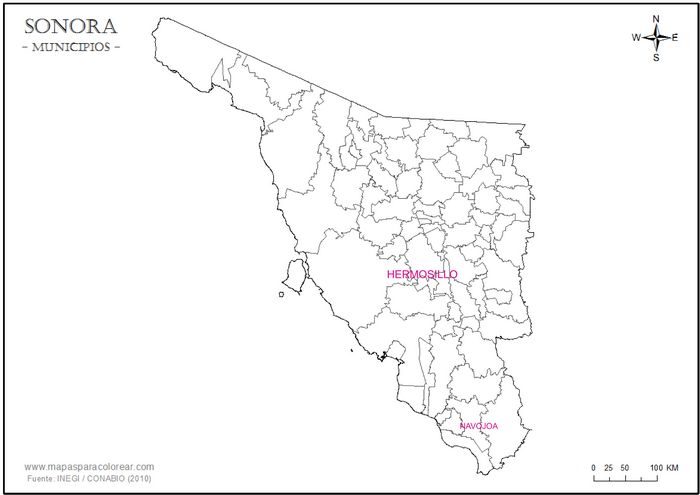
In 1943, during the Second World War, Mexico was again faced with an acute shortage of fractional coinage, especially the 50c denomination. To relieve this situation the government authorised the banks and local Chambers of Commerce to issue cheques with the printed denominations of twenty-five and fifty centavos.
Hermosillo
In Hermosillo the local paper, El Pueblo, referred to the various different private issues of red, blue, yellow and cream as “confetti”This might also be an allusion to the practice of splitting $1 Banco de México notes in half to create fractional currency. These 25c and 50c notes drove out any remaining small denomination coinsEl Pueblo, 15 December 1943.
Cámara Nacional de Comercio de Hermosillo
We know of one issue, a 50 centavos note issued by the Cámara Nacional de Comercio and dated 17 November 1943.
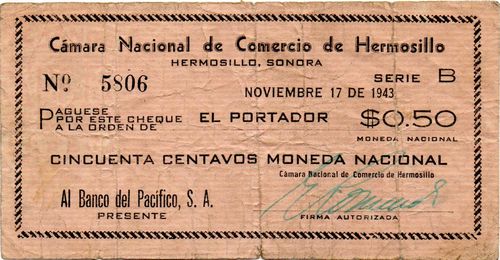
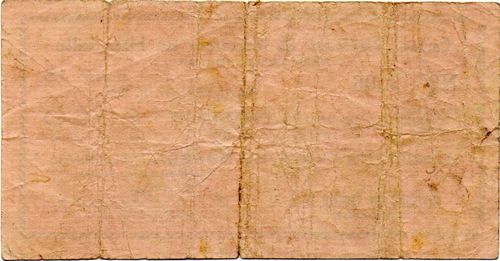
| series | from | to | total number |
total value |
||
| 25c | A | |||||
| 50c | B | includes number 5806 |
The signature is of E. Ro[ ][identification needed]
| E. Ro[ ] | 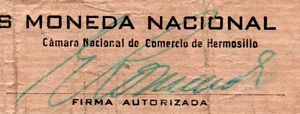 |
Navojoa
Cámara Nacional de Comercio del Mayo
In Navojoa the Cámara Nacional de Comercio del MayoThe Cámara was founded as the Cámara Agrícola y Comercial del Rio Mayo on 19 June 1921 at the invitation of Manuel Terminel (hijo), Salvador Y. Campoy, José A. Morales, Mariano García Sepúlveda and Gumersindo López, in the house of Manuel Terminel (hijo), who was appointed as its first president issued a fifty centavos cheque, dated 25 October 1943, drawn on the Banco Agricola SonorenseThe Banco Agricola Sonorense was a new banking institution established in Ciudad Obregón in 1933 by various groups with interests in agriculture. Francisco L. Terminel and Waldo Morali brought together the Confederación de Asociaciones Agrícolas del Estado de Sonora (represented by president Fernando Aguilar and secretary Jorge J. Parada); the Asociación de Productores de Trigo del Yaqui (represented by president Benjamín F. Brunk Jr.and secretary Jorge J. Parada); the Asociación de Productores de Arroz de la Región Agrícola del Yaqui (represented by president Alberto Astiazarán, and secretary José María Parada); the Asociación de Productores de Chícharo y Tomate de la Región Agrícola del Yaqui (represented by president Vicente Mexía Jr.and secretary Manuel M. Escamilla) and the Asociación de Productores de Garbanzo, Frijol y Cereales de la Región Agrícola del Mayo (represented by president Ildefonso Salido and secretary Ramón Salido). Terminel and Morali received authorisation on 27 April 1933 from Alberto J. Pani, the Secretario de Hacienda y Crédito Público, to set up the bank. It was to be based in Ciudad Obregón, but could establish agencies and branches throughout Sonora and the other states and have agencies, representations or branches abroad. The bank could have a capital of up to $1,500,000, represented by 150,000 $10 shares, of which $500,000 was subscribed at its establishment.
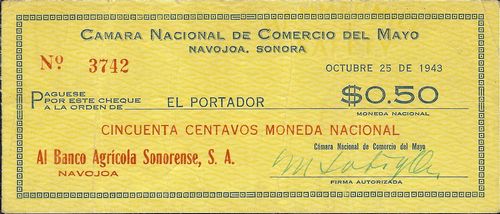
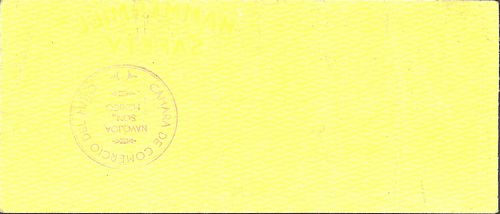
| series | from | to | total number |
total value |
||
| 50c | includes number 3742 |
The known signature is Manuel Soto y OleaThe officers elected for 1943, so potential signatories, are Presidente, Rafael J. Almada; Secretario, Ildefonso A. Félix; Tesorero, Dr. Pedro Ibarra G.; Comisario Propietario, Jesús Ruy Sánchez; Comisario Suplente, Manuel R. González; Gerente, Joaquín A. Mange; Consejeros Propietarios, Manuel Soto y Olea, Policarpio Garza, Rafael L. Félix, Agustín Zaragoza, Agustín Von Boerstel, José A. Morales Jr. And Bartolomé Rochín; Consejeros Suplentes, Carlos González Agraz, Avelino Fernández C., Francisco J. Terminel, Rodolfo Lara G., Aristeo A. Antúnez, Manuel J. Guereña, Tiburcio G. Soto, Santiago Garza, Nicolás J. Cervantes and Antonio R. Bours.
|
Manuel Soto y Olea was the owner of La Popular, a store on the ground floor of the Aguilera building. He had been president of the Cámara in 1939. |
 |
Elsewhere people resorted to other means. In Ciudad Obregón they cut $1 Banco de México notes in half, a practice that was also accepted in HermosilloEl Pueblo, 15 December 1943 whilst in Nogales they made use of American coins, one U.S. cent being taken for five Mexican centavos and the U. S. nickel standing in for twenty-five centavosEl Pueblo, 22 December 1943.
